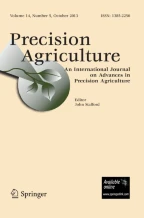Abstract
In this study, an inexpensive camera-observation system called the Crop Phenology Recording System (CPRS), which consists of a standard digital color camera (RGB cam) and a modified near-infrared (NIR) digital camera (NIR cam), was applied to estimate green leaf area index (LAI), total LAI, green leaf biomass and total dry biomass of stalks and leaves of maize. The CPRS was installed for the 2009 growing season over a rainfed maize field at the University of Nebraska-Lincoln Agricultural Research and Development Center near Mead, NE, USA. The vegetation indices called Visible Atmospherically Resistant Index (VARI) and two green–red–blue (2g–r–b) were calculated from day-time RGB images taken by the standard commercially-available camera. The other vegetation index called Night-time Relative Brightness Index in NIR (NRBINIR) was calculated from night-time flash NIR images taken by the modified digital camera on which a NIR band-pass filter was attached. Sampling inspections were conducted to measure bio-physical parameters of maize in the same experimental field. The vegetation indices were compared with the biophysical parameters for a whole growing season. The VARI was found to accurately estimate green LAI (R2 = 0.99) and green leaf biomass (R2 = 0.98), as well as track seasonal changes in maize green vegetation fraction. The 2g–r–b was able to accurately estimate total LAI (R2 = 0.97). The NRBINIR showed the highest accuracy in estimation of the total dry biomass weight of the stalks and leaves (R2 = 0.99). The results show that the camera-observation system has potential for the remote assessment of maize biophysical parameters at low cost.
Similar content being viewed by others
References
Ciganda, V., Gitelson, A., & Schepers, J. (2008). Vertical profile and temporal variation of chlorophyll in maize canopy: Quantitative “Crop Vigor” indicator by means of reflectance-based techniques. Agronomy Journal, 100(5), 1409–1417.
Cowling, S. A., & Field, C. B. (2003). Environmental control of leaf area production: Implications for vegetation and land-surface modeling. Global Biogeochemical Cycles, 17(1), 1–14. doi:10.1029/2002GB001915.
Gitelson, A. A., Kaufman, Y. J., Stark, R., & Rundquist, D. (2002). Novel algorithms for remote estimation of vegetation fraction. Remote Sensing of Environment, 80(1), 76–87.
Law, B. E., Arkebauer, T., Campbell, J. L., Chen, J., Sun, O., Schwartz, M., van Ingen, C., & Verma, S. (2008). Terrestrial carbon observations: Protocols for vegetation sampling and data submission. Report 55, Global Terrestrial Observing System. Rome: FAO.
Matsuda, M., Ozawa, S., Hosaka, Y., Kaneda, K., & Yamashita, H. (2003). Estimation of plant growth in paddy field based on proximal remote sensing—measurement of leaf nitrogen contents by using digital camera. Journal of the Remote Sensing Society of Japan, 23(5), 506–515 (in Japanese with English abstract).
Meyer, G. E., Hindman, T. W., & Laksmi, K. (1999). Machine vision detection parameters for plant species identification (G. E. Meyer, & J. A. DeShazer, Eds.) (pp. 327–335). Boston, MA, USA: SPIE.
Meyer, G. E., & Neto, J. C. (2008). Verification of color vegetation indices for automated crop imaging applications. Computers and Electronics in Agriculture, 63(2), 282–293.
Perez, A. J., Lopez, F., Benlloch, J. V., & Christensen, S. (2000). Colour and shape analysis techniques for weed detection in cereal fields. Computers and Electronics in Agriculture, 25(3), 197–212.
Richardson, A. D., Jenkins, J. P., Braswell, B. H., Hollinger, D. Y., Ollinger, S. V., & Smith, M. L. (2007). Use of digital webcam images to track spring green-up in a deciduous broadleaf forest. Oecologia, 152(2), 323–334.
Ritchie, S. W., Hanway, J. J., Benson, G., & Herman, J. (2005). How a corn plant develops. Ames, IA, USA: Iowa State University of Science and Technology Cooperative Extension Service.
Sakamoto, T., Shibayama, M., Takada, E., Inoue, A., Morita, K., Takahashi, W., et al. (2010). Detecting seasonal changes in crop community structure using day and night digital images. Photogrammetric Engineering and Remote Sensing, 76(6), 713–726.
Sakamoto, T., Shibayama, M., Kimura, A., & Takada, E. (in press). Assessment of digital camera-derived vegetation indices in quantitative monitoring of seasonal rice growth. ISPRS Journal of Photogrammetry and Remote Sensing.
Tucker, C. J. (1979). Red and photographic infrared linear combinations for monitoring vegetation. Remote Sensing of Environment, 8(2), 127–150.
Woebbecke, D. M., Meyer, G. E., Vonbargen, K., & Mortensen, D. A. (1995). Color indices for weed identification under various soil, residue, and lighting conditions. Transactions of the ASAE, 38(1), 259–269.
Acknowledgments
We gratefully acknowledge the use of facilities and equipment provided by the National Drought Mitigation Center (NDMC), University of Nebraska-Lincoln (UNL). We are grateful to Dr. Don Wilhite, Dr. Mike Hayes, Mr. Todd Schimelfenig and Ms. Deborah Wood of SNR for their valuable comments and research support. We offer special thanks to Mr. Tom Lowman, Lab Manager at Agricultural Meteorology Lab at Mead, for his technical support on the field investigation and the observation equipment, and to Mr. Dave Scoby for his technical support of the plant measurements of maize. We would like to thank Kazuhiro Morita in the Toyama Prefectural Agricultural Forestry and Fisheries Research Center, Wataru Takahashi in the Toyama Prefectural Office, Agriculture, Forestry and Fisheries Department, Dr. Eiji Takada, Mr. Akihiro Inoue in the Toyama National College of Technology, Shigenori Miura in National Agricultural Research Center and Mr. Akihiko Kimura in Kimura Ouyo-Kougei, Ltd for their supports of field measurement and providing agronomic-survey data of rice and barley. This work was supported by the Japanese Society for the Promotion of Science; JSPS Postdoctoral Fellowships for Research Abroad.
Author information
Authors and Affiliations
Corresponding author
Rights and permissions
About this article
Cite this article
Sakamoto, T., Gitelson, A.A., Wardlow, B.D. et al. Application of day and night digital photographs for estimating maize biophysical characteristics. Precision Agric 13, 285–301 (2012). https://doi.org/10.1007/s11119-011-9246-1
Published:
Issue Date:
DOI: https://doi.org/10.1007/s11119-011-9246-1
